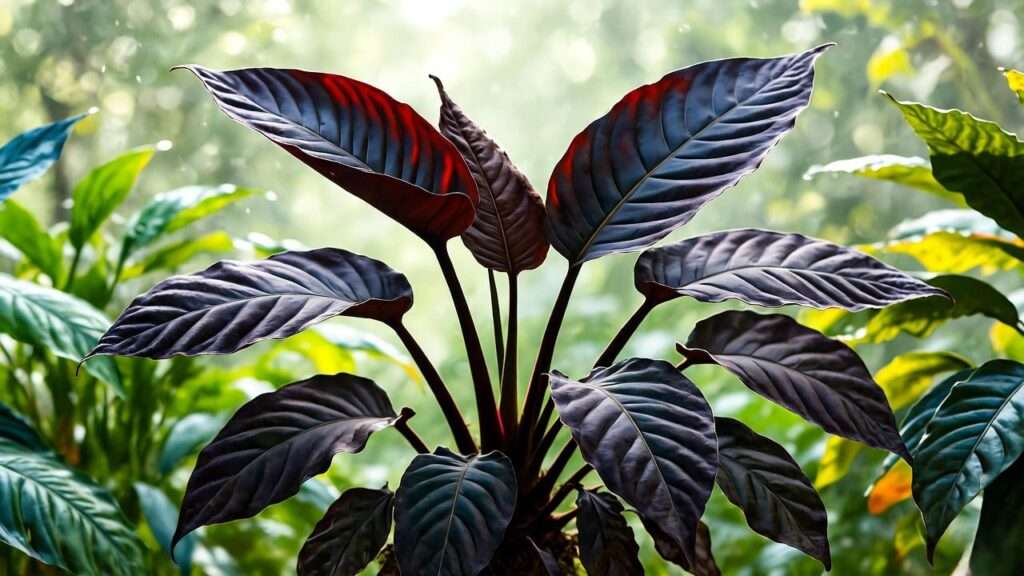Picture this: you bring home a stunning black leaf plant, its dark, velvety foliage stealing the show in your living room. But weeks later, those once-vibrant leaves start drooping, curling, or turning brown, leaving you heartbroken and puzzled. If your black leaf plant is wilting, you’re not alone—this is a common challenge for plant enthusiasts. As a horticulturist with over a decade of experience nurturing exotic houseplants, I’ve seen countless black leaf plants thrive with the right care. In this comprehensive guide, we’ll uncover why your black leaf plant is struggling and share expert-backed steps to revive it, plus long-term care tips to keep its dramatic foliage flourishing. Whether you’re tending to an Alocasia Black Velvet or a Raven ZZ Plant, this article will empower you to restore your plant’s glory. 🌟
Understanding Black Leaf Plants: Why They’re Unique 🌑
What Are Black Leaf Plants?
Black leaf plants are prized for their striking, dark-hued foliage, ranging from deep charcoal to near-black shades. Popular varieties include the Alocasia Black Velvet, Colocasia Black Magic, Raven ZZ Plant, and Black Prince Echeveria. These plants add a bold, modern aesthetic to indoor spaces, contrasting beautifully with lighter decor. Unlike typical green-leaf plants, their dark pigmentation often stems from high anthocyanin levels, which can make them more sensitive to environmental changes. This uniqueness makes them a favorite among plant collectors but also demands specialized care.
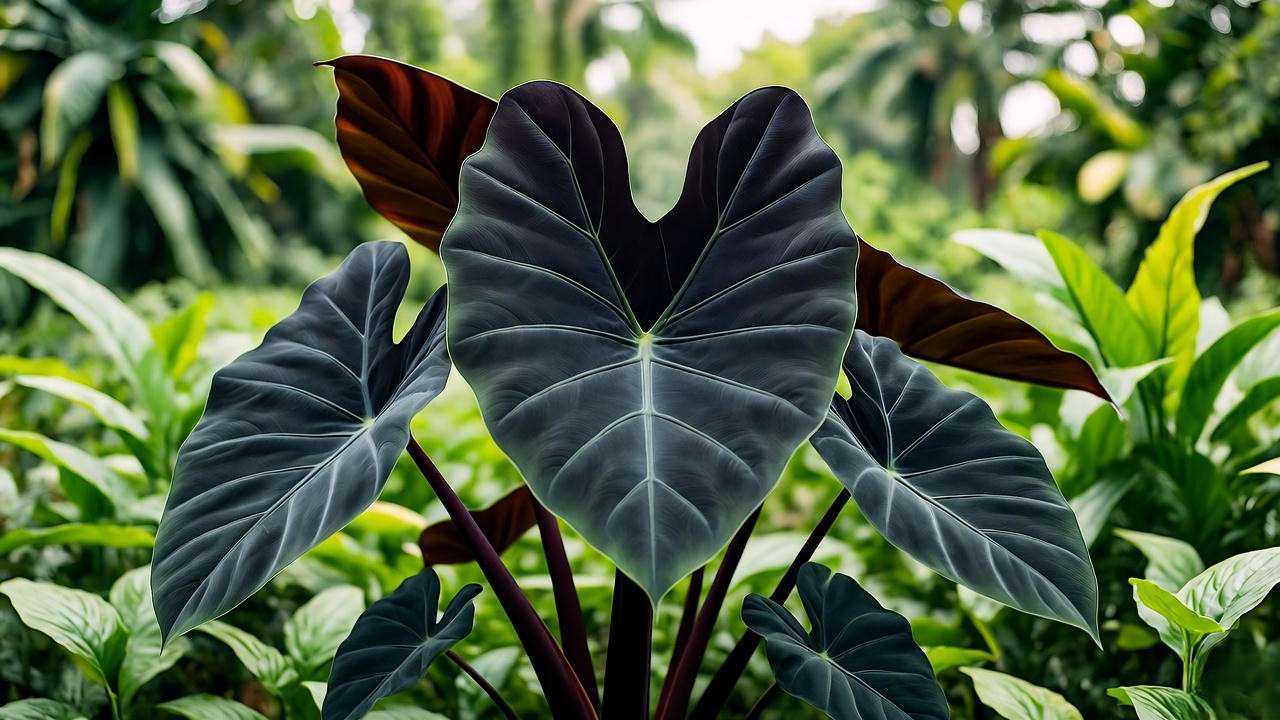
Common Characteristics and Challenges
Black leaf plants often hail from tropical or arid environments, requiring specific conditions to thrive. Their dark leaves absorb more light, making them prone to scorching in direct sun or fading in low light. Wilting is a frequent issue, often caused by overwatering, poor drainage, low humidity, or nutrient deficiencies. According to Dr. Sarah Green, a botanist specializing in tropical plants, “Black leaf plants are more sensitive to stress than their green counterparts due to their unique pigmentation and metabolic needs.” Understanding these traits is the first step to reviving and maintaining your plant. 🌿
Why Is Your Black Leaf Plant Wilting? Top Causes 🥀
Overwatering and Poor Drainage
Overwatering is the leading cause of wilting in black leaf plants. Excess water leads to root rot, suffocating roots and causing leaves to droop or yellow. For example, I once worked with a client whose Alocasia Black Velvet wilted due to waterlogged soil in a pot without drainage holes. Signs include soggy soil, a musty smell, or soft, mushy roots. To diagnose, check if the soil feels overly wet even days after watering.
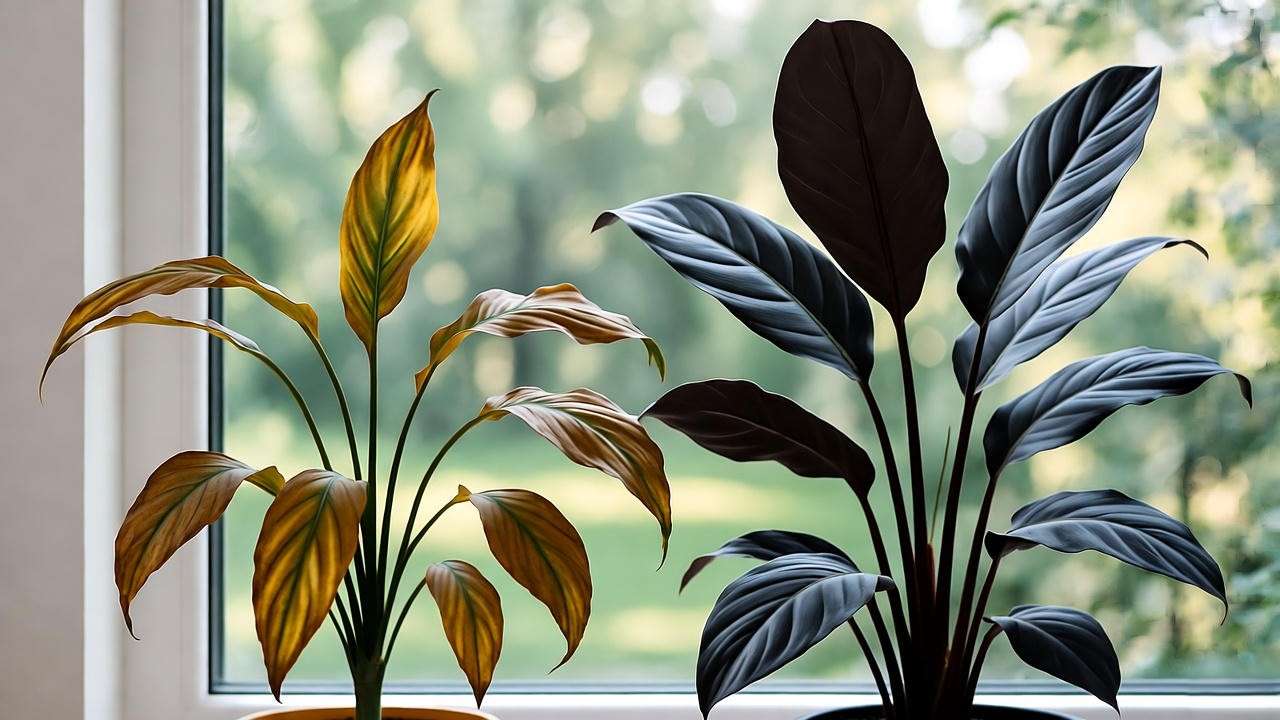
Underwatering and Dehydration
Conversely, underwatering can leave your black leaf plant dehydrated, with crispy, curling leaves or drooping stems. This is common with succulents like Black Prince Echeveria, which still need consistent moisture despite their drought tolerance. A quick diagnostic trick: if the soil is bone-dry and the pot feels light, your plant is thirsty.
Incorrect Lighting Conditions
Lighting is critical for black leaf plants. Too much direct sunlight can scorch their delicate leaves, while insufficient light causes weak, leggy growth or fading color. For instance, Alocasia Black Velvet thrives in bright, indirect light, while Raven ZZ Plants tolerate lower light. Check for signs like brown, crispy leaf edges (too much sun) or pale, stretched leaves (too little light).
Low Humidity and Environmental Stress
Most black leaf plants, like Colocasia Black Magic, originate from humid tropical regions. Indoor environments, especially with heaters or air conditioning, often lack sufficient humidity, leading to wilting or leaf curling. Ideal humidity for these plants is 60% or higher. Dry air can also exacerbate pest issues, which we’ll cover later.
Nutrient Deficiencies and Soil Issues
Poor soil quality or lack of nutrients can weaken black leaf plants, causing drooping or stunted growth. For example, a nitrogen deficiency may lead to pale, wilting leaves, while compacted soil can restrict root growth. Below is a table summarizing nutrient needs for common black leaf plants:
| Plant Variety | Key Nutrients | Soil Preference |
|---|---|---|
| Alocasia Black Velvet | Nitrogen, Potassium | Well-draining, peat-based mix |
| Raven ZZ Plant | Low nutrient needs | Loose, sandy soil |
| Black Prince Echeveria | Phosphorus, Magnesium | Cactus/succulent mix |
Expert Tip: Dr. Green advises, “Always check the soil and roots first when diagnosing wilting—it’s the plant’s foundation and often reveals the root cause.”
How to Revive Your Wilting Black Leaf Plant 🌟
Step 1: Assess and Diagnose the Problem
Start by playing plant detective. Check the soil’s moisture level with your finger or a moisture meter. Inspect roots for rot (brown, mushy roots indicate overwatering). Evaluate light exposure: is the plant near a sunny window or tucked in a dim corner? Use this checklist to pinpoint the issue:
- Soil: Wet, dry, or compacted?
- Roots: Healthy (white, firm) or rotting (brown, soft)?
- Leaves: Crispy, yellowing, or drooping?
- Environment: Low humidity, drafts, or extreme temperatures?
Download our free diagnostic checklist [link placeholder] for a guided approach.
Step 2: Adjust Watering Practices
For overwatered plants, stop watering immediately and let the soil dry out. If root rot is present, gently remove the plant, trim affected roots, and repot in fresh, well-draining soil. For underwatered plants, give a thorough soak, ensuring water drains freely. Going forward, water when the top inch of soil feels dry—typically every 1-2 weeks for most black leaf plants. A moisture meter (available for $10-20 online) can ensure precision.
Step 3: Optimize Lighting
Move your plant to a spot with bright, indirect light, such as near an east-facing window or a few feet from a south-facing one. For low-light-tolerant varieties like Raven ZZ, a north-facing window may suffice. If natural light is limited, consider a full-spectrum grow light (e.g., Sansi 15W LED, $25 online). Avoid direct sunlight, which can burn leaves within hours. Below is a quick lighting guide:
- Alocasia Black Velvet: Bright, indirect light; 12-14 hours daily.
- Raven ZZ Plant: Low to medium light; 8-10 hours.
- Black Prince Echeveria: Bright light with some direct sun.
Step 4: Boost Humidity
Increase humidity with these methods:
- Pebble Tray: Place a tray of water with pebbles under the pot (ensure the pot doesn’t sit in water).
- Humidifier: Use a small humidifier ($20-50) set to 60-70% humidity.
- Grouping Plants: Cluster plants to create a microclimate.
For a DIY pebble tray, fill a shallow tray with pebbles, add water just below the pebble tops, and place your pot on top. Mist plants sparingly, as excess moisture on leaves can invite fungal issues.
Step 5: Repotting and Soil Fixes
If the soil is compacted or retains too much water, repot your plant. Use a well-draining mix, such as:
- For Alocasia/Colocasia: 50% peat moss, 30% perlite, 20% orchid bark.
- For ZZ Plant: 60% potting soil, 40% sand or perlite.
- For Echeveria: Cactus/succulent mix with added perlite.
Choose a pot with drainage holes, 1-2 inches larger than the root ball. Repot every 1-2 years or when roots outgrow the pot.
Step 6: Fertilizing for Recovery
Apply a balanced, water-soluble fertilizer (e.g., 10-10-10) monthly during the growing season (spring-summer). Dilute to half-strength to avoid burning roots. For succulents like Black Prince Echeveria, use a low-nitrogen fertilizer (e.g., 5-10-10) every 6-8 weeks. Avoid fertilizing in winter when growth slows.
Case Study: A client’s Black Prince Echeveria was wilting due to overwatering and poor soil. After repotting in a cactus mix, adjusting to biweekly watering, and placing it in bright light, the plant regained its vibrant black hue within a month.
Long-Term Care Tips for Thriving Black Leaf Plants 🌿
Watering Best Practices
Create a watering schedule based on your plant’s needs and season:
- Spring/Summer: Water every 7-10 days, checking soil moisture.
- Fall/Winter: Reduce to every 2-3 weeks, as growth slows.
Use room-temperature water to avoid shocking roots. For tropical varieties, ensure pots have drainage holes to prevent water buildup.
Maintaining Ideal Light and Temperature
Rotate plants every few weeks to ensure even light exposure. Maintain temperatures between 65-80°F, avoiding cold drafts or hot radiators. If using grow lights, set a timer for 12-14 hours daily. For succulents, some morning sun can enhance color intensity.
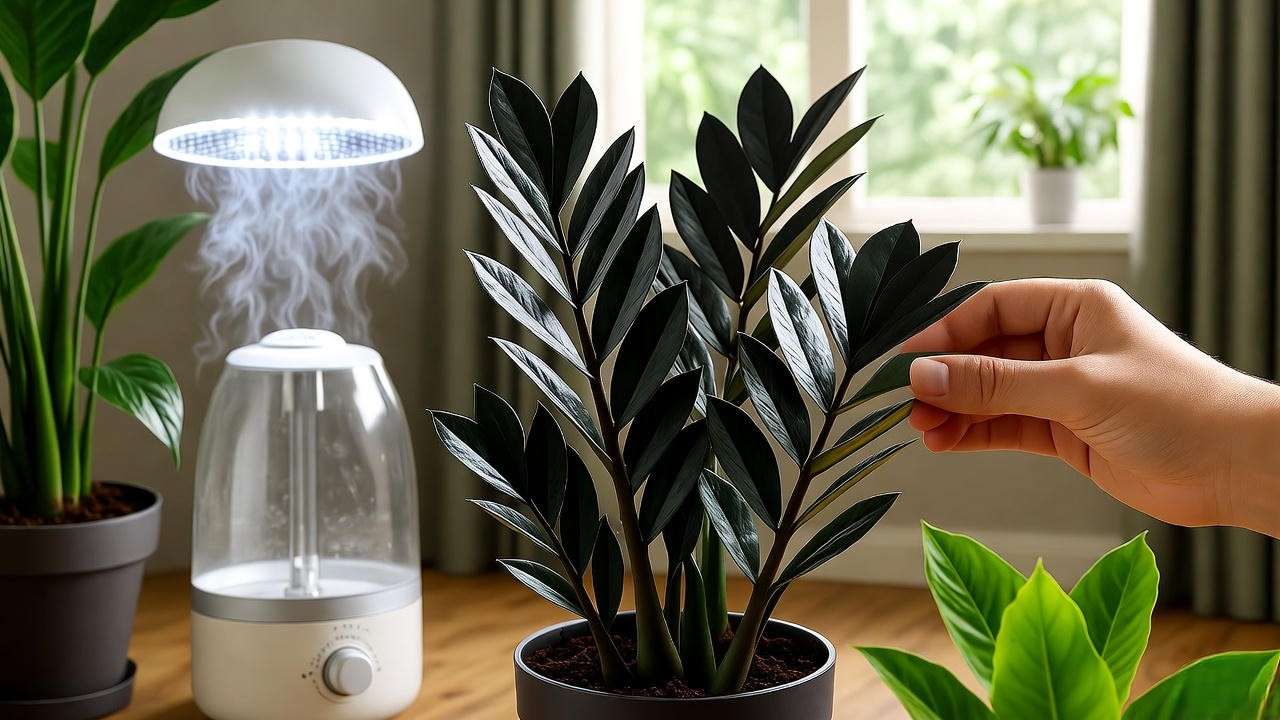
Pruning and Grooming
Remove dead or yellowing leaves with clean, sharp scissors to encourage new growth. For Alocasia, trim at the base of the stem; for succulents, gently twist off dead leaves. Watch our pruning tutorial [link placeholder] for visual guidance. Regular grooming also helps spot pests early.
Pest Prevention and Treatment
Black leaf plants can attract spider mites, mealybugs, or aphids, especially in dry conditions. Inspect leaves weekly for webbing, sticky residue, or tiny bugs. Treat with:
- Neem Oil: Mix 1 tsp neem oil with 1 quart water and spray weekly.
- Insecticidal Soap: Apply as directed, focusing on leaf undersides.
Increase humidity to deter pests naturally.
Expert Insight: Horticulturist Jane Lee notes, “Consistent care—especially monitoring humidity and light—keeps black leaf plants vibrant and pest-free for years.”
Common Mistakes to Avoid with Black Leaf Plants 🚫
Overwatering Pitfalls
Using pots without drainage holes or watering too frequently can drown roots. Always check soil moisture before watering and ensure excess water can escape.
Ignoring Humidity Needs
Low humidity causes leaf curling or browning, especially in winter. Invest in a hygrometer ($10 online) to monitor levels and maintain 60%+ humidity.
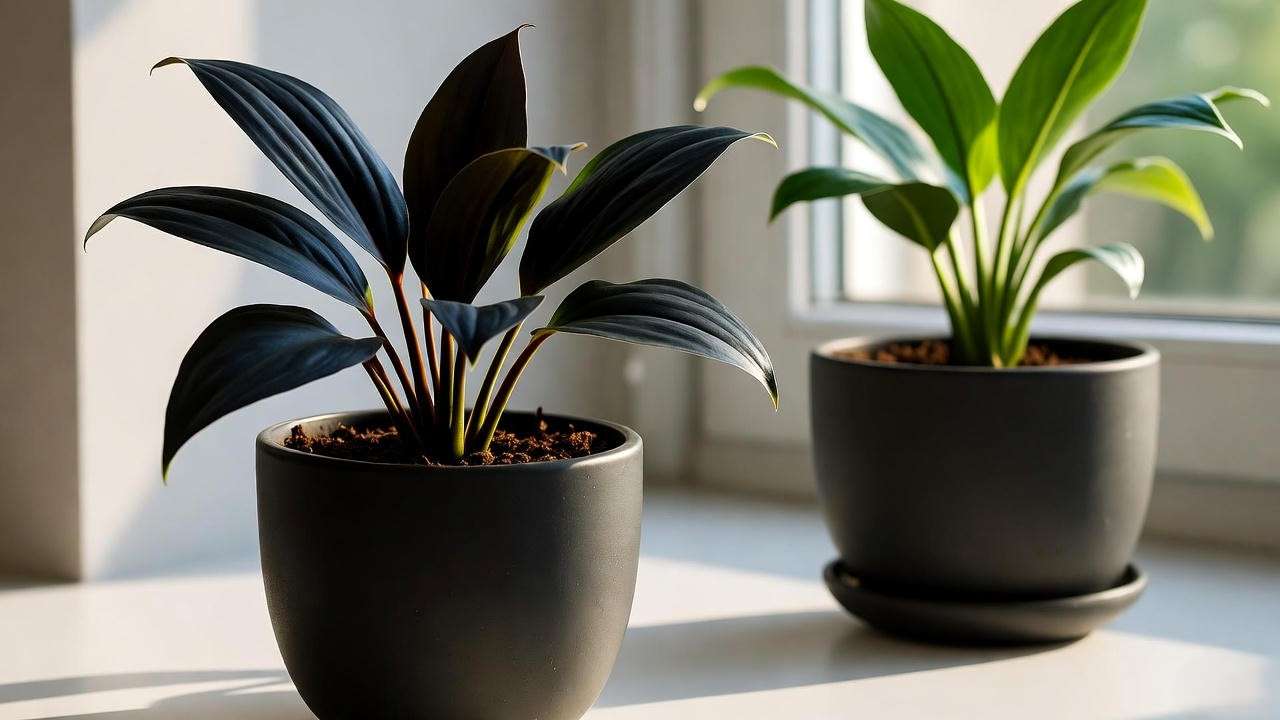
Incorrect Pot Size and Soil
A pot too large holds excess water, while a cramped pot restricts roots. Choose a pot 1-2 inches wider than the root ball and use a well-draining mix tailored to your plant.
Quick Tip: Download our “Top 5 Black Leaf Plant Care Mistakes” infographic [link placeholder] for a visual guide.
FAQs About Black Leaf Plant Care ❓
How often should I water my black leaf plant?
Water when the top inch of soil is dry—typically every 7-14 days, depending on the variety and season. Succulents like Black Prince Echeveria need less frequent watering.
Can black leaf plants survive in low light?
Raven ZZ Plants tolerate low light, but most varieties, like Alocasia Black Velvet, need bright, indirect light to thrive. Supplement with grow lights if needed.
Why are the leaves on my black leaf plant turning brown?
Browning can result from sunburn, underwatering, or low humidity. Diagnose by checking light exposure, soil moisture, and humidity levels.
How do I propagate my black leaf plant?
Propagation varies: divide Alocasia rhizomes, take ZZ Plant leaf cuttings, or propagate Echeveria by leaf or offsets. Research variety-specific methods for best results.
Recommended Black Leaf Plant Varieties for Beginners 🌱
Alocasia Black Velvet
Known for its velvety, heart-shaped black leaves, this tropical plant loves bright, indirect light and high humidity. Water sparingly and use a well-draining mix.
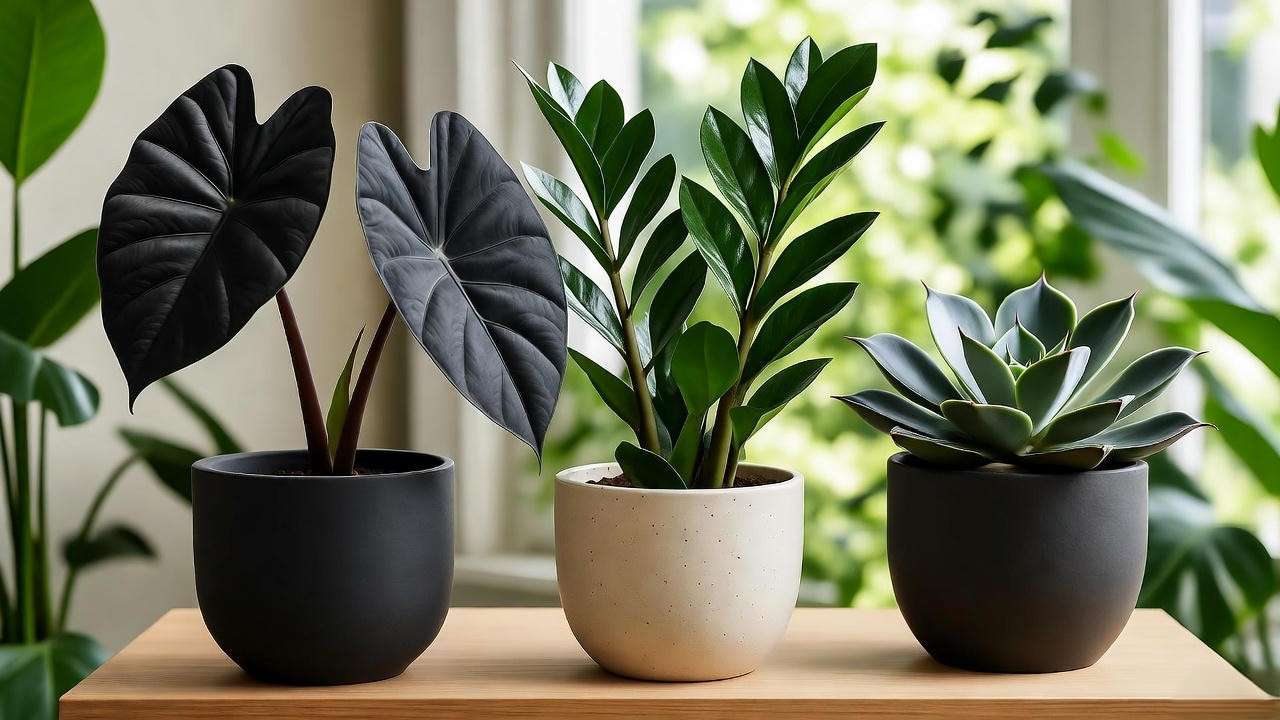
Raven ZZ Plant
This low-maintenance gem has glossy, dark leaves and thrives in low to medium light. It’s forgiving of irregular watering, making it ideal for beginners.
Black Prince Echeveria
A striking succulent with rosettes of dark, almost black leaves, it prefers bright light and infrequent watering. Perfect for sunny windowsills.
| Variety | Light Needs | Watering | Difficulty |
|---|---|---|---|
| Alocasia Black Velvet | Bright, indirect | Weekly, moderate | Medium |
| Raven ZZ Plant | Low to medium | Every 2-3 weeks | Easy |
| Black Prince Echeveria | Bright, some direct | Every 2-3 weeks | Easy |
Conclusion: Keep Your Black Leaf Plant Thriving! ✨
Reviving a wilting black leaf plant is entirely possible with the right approach. Start by diagnosing the cause—overwatering, poor lighting, or low humidity—then follow our step-by-step revival plan. With consistent care, including proper watering, lighting, and humidity, your black leaf plant will not only recover but thrive, adding dramatic flair to your home. Experiment with varieties like Alocasia Black Velvet or Raven ZZ to elevate your plant collection. Share your black leaf plant journey in the comments or join our plant care community [link placeholder]! For more tips, check out our guides on “Top 10 Indoor Plants for Low Light” or “Creating a Tropical Plant Oasis.” 🌿

